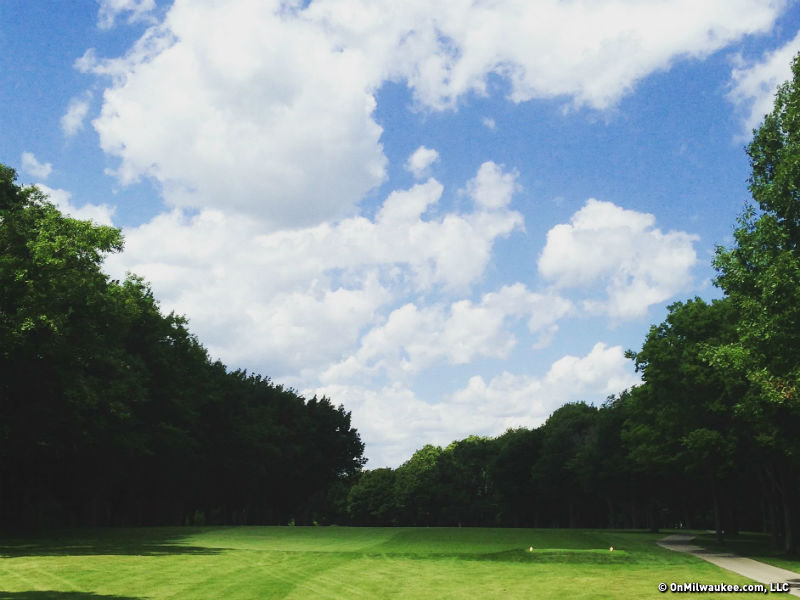ERIN, Wis. – One day in June, golfers were stuck out on the rural course, forced to wait out the storm in a steamy hut. Not an unusual occurrence on a Wisconsin course in summer – except only two of the golfers were from Wisconsin. The rest were fanatics from Australia, greater New York City and Pittsburgh – all of whom had traveled to the Badger State to play championship golf courses.
It's a travel trend that started when Herb Kohler partnered with famed course designer Pete Dye. Together, they built four of the world's best public-access courses in Kohler and north of Kohler – the best known of which is the Straits course at Whistling Straits on the Lake Michigan coast, where two men's PGA championships have been held. Now destination golfers from around the world are checking Erin Hills off their bucket lists.
Why? For a course that's only five years old?
Because the United States Golf Association, the governing body of the sport, has made Erin Hills an instant classic that will host the men's U.S. Amateur championship this August 22-28 and a men's U.S. Open in 2017. It already hosted the U.S. Women's Am and the Public Links Championship. The course, about 30 miles northwest of Milwaukee with views of Holy Hill, is so good that the persnickety USGA scoped out the course while it was under construction.
Many a course advertises itself as an ''inland links'' design. Few fit the bill like Erin Hills, situated on an exquisite piece of natural property that makes you think there's an ocean just over the next bluff, a peat shepherd's hut on the next rise and an old pub serving Guinness at the next turn.
It will be closed August 13-28 to prepare for and host the men's U.S. Amateur. Seeing that event and the future stars of the sport will cost you little except time and some gas money. Admission and parking will be free.
The price of admission to play this Michael Hurdzan-Dana Fry-Ron Whitten masterpiece is quite steeper: $290 when you throw in the caddy fee and tip. You can carry your own bag over the windswept hills and dales and save about $90. But I recommend a caddy to guide you around the place and help you find your ball. And yes, you must walk. After all, that's the way golf was meant to be played – on foot, in the elements, testing the turf and feeling the breeze off the fescue.
With its enhanced on-site accommodations, Erin Hills has the feel of a Midwest version of Bandon Dunes, the remote golfers' paradise on Oregon's rocky coast.
But luckily your round won't be played at the distance the mostly muscular young male participants will be up against. Erin Hills will be set up to play to a par of 36-36—72 at – you are reading this correctly -- 7,760 yards, the longest course in USGA history.
Sure the fairways will be firm and the ball will run, but that's long for even the biggest bombers wielding those big-headed metal drivers. And that's not even the tips of this course, which measure 7,820 yards for 18 holes. Most of us, thankfully, are teeing it up at courses a little north of 6,000 yards. The ''short'' tees at Erin Hills measure 6,423 yards. On that one June day, I teed it up from 6,712 yards and managed to tally 47 for the first 9 holes I could get in between the lightning bolts and the raindrops and leaving time for a draft beer on the expansive veranda that allows a fantastic sunset over the golfing landscape.
Every bit of that landscape is something to behold. Hurdzan, Fry and Whitten took a minimalist approach from the beginning. Unlike Dye's daunting Straits course, crafted from on old military facility by bulldozer and tons of dirt, the designers of Erin Hills had Mother Nature's best handiwork at their disposal. They were smart enough to take what was given them.
They came back to tweak their design last year, eliminating some of the quirky things that didn't quite work and making sure the course could accommodate the best golfers in the world and the spectators that follow them. Sand traps were enhanced, cart paths were eliminated and plots of fescue were over-seeded. All to enhance the experience and the golf course.
The remodeling is most evident on No. 10, which went from a par 5 to a very long par 4, around 500 yards. The tee shot was and remains a blind one up and over a verdant rise. The initial green was a narrow roller coaster of a putting surface. They moved up the green to the former landing area for the final approach and built a sand and mound complex that will allow spectators to easily see golfers trying to attack a pin that rarely will be situated in a safe spot on this sloping, two-tiered putting surface. In addition, a blind par 3 hole on the front nine, part of the initial design, is no more, now part of the par 5 seventh hole. The warning bell remains to the right in the rough as a reminder.
No. 15 is one they got right the first time. This 370-yard par-4 tester begins from an elevated tee and runs downhill past high grasses to a rolling lowland by a creek. Then it doglegs left sharply uphill to a green atop a steep mound, surrounded by deep bunkers from which even the golf legends of tomorrow may not emerge with ease. You can try it for yourself, for a price. Or you can see during the "Am,'' for free. And unlike all those visitors from out of state, no flight is necessary to tread on what's become a major venue for destination golfers.







